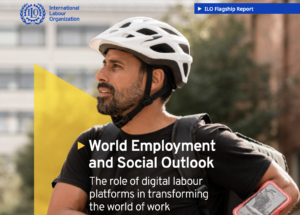Can online labour platforms bring jobs to the countryside?

Digital technologies have created new online marketplaces and industries, and they fundamentally changed how we live and work. But until recently, they have not changed where we work. The internet brought cloud platforms, video calls, and virtual teamwork, but the jobs still clustered in metropolitan areas. The Covid-19 pandemic might now mark a turning point to this coalition between digitisation and urbanisation.
While the lockdown forced many of us to work from home, organisations have started to realise the benefits of virtual collaboration and many business processes are now remote by default. Suddenly, it is not inconceivable anymore to hire people on full-remote contracts, and access to talent becomes more important than the water cooler chat.
Remote work could therefore become a chance for people in rural areas. Pre-covid, they were limited to the local labour market in their region or they had to commute or migrate to the next big city for work. In the highly digitised world of work we’re living in now, online labour platforms might offer an alternative for rural workers. They could register on such platforms to work virtually for employers from urban centres or the other end of the world. Indeed, a 2020 study by our colleagues shows that online labour has taken up momentum since the start of the pandemic.
In our study ICTs and the urban-rural divide: can online labour platforms bridge the gap? (together with Vili Lehdonvirta and Otto Kässi) we took a closer look into this, as we investigated the differences in online labour activity between metropolitan areas and the countryside.
To do so, we focused on the regional distribution of online labour participation in the United States; one of the largest markets for online labour globally. We matched the transaction records of 34,000 individual projects from a globally leading online labour platform with regional data from the US Census Bureau and mapped the online job categories to official statistics from the US Bureau of Labour statistics. This allowed us to provide a quantitative assessment of the local economic factors that influence regional supply to the online labour market in more than 3,000 urban and rural counties of the United States.
The statistical analysis reveals three main insights into the geography of online labour participation:
- Relative to the local population size, rural counties made disproportionate use of the online labour market (see Fig. 1, panel A).
- Higher-skilled specialists in rural areas make even more use of online labour platforms: the average skill level of online labour provided by rural regions is higher than that of urban regions (see Fig. 1, panel B).
- While the online labour market seems to provide an option for rural specialists to find work at a distance, the least urbanised regions of the country have not been participating at all (Fig. 2).
In summary, our study shows that online labour participation is not equally distributed across the urban and rural regions, but instead mirrors the spatial distribution of economic opportunities in different locations. Counties with a strong local economy, a high education level, and good internet connectivity host the largest freelancer communities.
The takeaway from our study is that the internet, so far, has not overcome the ‘tyranny of distance’ (Paul Virilio, 1993). Digital technologies, such as online labour platforms, can help people in rural regions to make their living, and it is expected that the trend towards remote work is only to continue in the future. However, the strong link between local economic opportunities and online labour participation shows that one should not be over-optimistic about the potential of digital platforms to solve all the spatial limitations of the labour market.
People in remote regions will not find the local opportunities to develop the specialised types of digital skills, such as programming or web-development, which are in high demand in urban areas. The online labour market prospects of people living in rural areas are mirroring the prospects of their local labour markets. If we want to bring more online jobs to the countryside, we need to focus on improving the local economy, infrastructure, and education in these regions.
Read more: Fabian Braesemann, Vili Lehdonvirta & Otto Kässi (2020) ICTs and the urban-rural divide: can online labour platforms bridge the gap?, Information, Communication & Society, DOI:10.1080/1369118X.2020.1761857
Author: Fabian Braesemann
Other posts:




